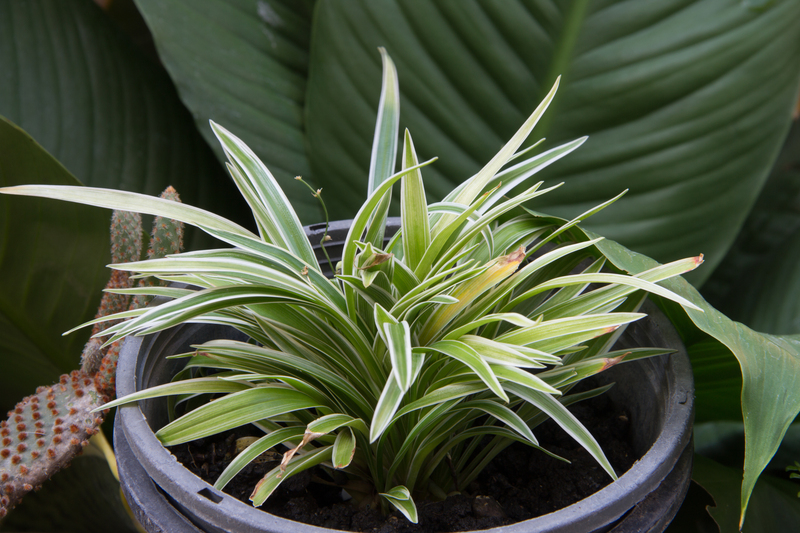Step-by-Step to a Thriving Garden Makeover
Posted on 03/09/2025
Step-by-Step to a Thriving Garden Makeover
A flourishing garden is not simply a result of random planting--it's the outcome of careful planning, patient execution, and ongoing care. If you're looking for practical guidance on how to transform your outdoor space into a beautiful and sustainable oasis, you've landed in the right place. This comprehensive step-by-step guide to a thriving garden makeover covers everything from design and soil preparation to planting and long-term maintenance. Whether you have a small urban plot or sprawling suburban backyard, you'll find strategies and ideas tailored to craft your own little paradise.

Why Invest in a Garden Makeover?
A garden transformation not only enhances curb appeal but also raises property value, creates a healthier environment, and provides a tranquil space for relaxation and recreation. More importantly, a beautiful garden fosters biodiversity, allowing local wildlife and pollinators to thrive.
- Environmental Benefits: Reduced soil erosion, rainwater harvesting, and improved air quality.
- Healthful Lifestyle: Home-grown fruits, vegetables, and herbs.
- Well-being: Gardening is proven to reduce stress and encourage mindfulness.
- Community Value: An attractive garden brings neighbors together.
Step One: Assess and Plan Your Dream Garden Makeover
Evaluate Your Existing Space
Begin your garden renovation by assessing your current landscape. Walk through your garden and note:
- Sunny and shady spots
- Soil texture and drainage
- Existing plants worth keeping or removing
- Potential problem areas (e.g., invasive weeds or drainage issues)
Take photos and sketch a basic layout--your blueprint for the transformation. This step is crucial for any successful garden makeover.
Set Clear Goals and Priorities
What do you want from your garden? Make a list of priorities such as:
- Growing organic produce
- Creating a child- or pet-friendly space
- Attracting wildlife (birds, bees, butterflies)
- Year-round beauty with seasonal interest
- Entertainment or relaxation areas
Establishing your objectives will ensure the garden redesign is personalized and practical.
Design and Budget
Think about styles that inspire you--English cottage, Mediterranean, contemporary, or low-maintenance native plants. Browse online image galleries, visit public gardens, and collect inspiration.
- Draw a scaled plan or use user-friendly garden design apps.
- List the materials you'll need: compost, mulch, tools, plants, borders, decorations, etc.
- Decide what projects you can DIY and what may require professional help.
- Set a realistic budget, allowing a 10-15% cushion for unexpected expenses.
Step Two: Clear, Clean, and Prepare Your Garden
Remove Unwanted Plants and Debris
- Pull weeds and invasive species by the roots to prevent regrowth.
- Dispose of diseased or dead plants carefully, ensuring pathogens are not spread.
- Prune overgrown shrubs, trees, and hedges to their ideal shapes.
Tip: Recycle healthy plant material into compost or mulch for future use.
Level and Amend the Soil
- Fill in low spots, break up compacted areas, and create gentle slopes for proper drainage.
- Test your soil pH and adjust as needed (add lime to raise pH, sulfur to lower).
- Incorporate a thick layer of organic matter (compost, well-rotted manure, worm castings).
- Add slow-release fertilizers if required, based on your planned plantings.
A healthy base is integral for a thriving garden transformation.
Plan Edging, Paths, and Hardscape Features
- Install edging for lawn, beds, and pathways to contain materials and minimize maintenance.
- Create paths using gravel, stepping stones, or bark chips for easy movement and definition.
- Think about adding raised beds, arbors, pergolas, or seating areas to maximize space and style.
Step Three: Select the Right Plants
Choose According to Climate and Conditions
Not all plants will thrive in every garden. For a successful garden overhaul:
- Choose native and drought-resistant species for lower maintenance and resilience.
- Combine plants based on similar water, light, and soil requirements.
- Consider multi-layered planting: groundcovers, perennials, shrubs, and trees.
For a lush and biodiverse makeover garden, include:
- Pollinator-friendly flowers (lavender, echinacea, salvia)
- Edible crops (herbs, salad greens, fruit trees)
- Evergreen plants for year-round structure
- Seasonal bulbs for continuous color
Planting Time and Placement
Plan your planting for mild weather--spring or early autumn are best in most climates. Arrange plants in groups of odd numbers for a natural effect. Place taller plants in the back or center (if viewed from all sides), with lower-growing species along edges.
- Tip: Pay attention to mature plant size to avoid overcrowding.
Step Four: Smart Planting for a Thriving Garden
Prepare Holes and Plant Properly
- Dig holes at least twice the width of the root ball but no deeper.
- Loosen roots and dip them in water for bare-root plants.
- Backfill with a blend of native soil and compost, tamping gently.
- Water thoroughly and mulch to retain moisture.
For raised beds:
- Layer organic materials (twigs, leaves, compost) for improved drainage and nutrients.
- Space crops for airflow and sun access, practicing crop rotation annually.
The key to a successful garden makeover is patience--plants take time to establish!
Step Five: Mulch, Feed, and Water Efficiently
Mulching Tips
- Apply 2-4 inches of organic mulch (bark, straw, leaf mold) around plants--leave a small gap around stems to prevent rot.
- Mulch conserves moisture, suppresses weeds, and enriches soil over time.
Nutrient and Watering Strategies
- Fertilize sparingly; too much can harm plants and runoff into waterways.
- Use organic feeds or compost teas for a natural boost.
- Irrigate deeply but infrequently to encourage strong root growth--drip or soaker hoses are efficient and water-wise.
- Water early in the morning or late afternoon to minimize evaporation.
Pro tip: Install a rain barrel and use collected water for a more environmentally friendly garden makeover.
Step Six: Maintenance for a Flourishing Garden
Regular Care Tasks
- Deadhead spent blooms to prolong flowering.
- Prune as needed for shape, health, and productivity.
- Monitor for pests and diseases; use organic controls and natural predators whenever possible.
- Top up mulch annually and compost any green waste.
- Keep paths, seating, and features tidy for a welcoming atmosphere.
Seasonal Considerations for Sustainable Success
- Divide and transplant perennials in spring or fall.
- Replace summer annuals with bulbs or winter bedding for year-round interest.
- Protect tender plants from frost with covers or move pots indoors when necessary.
- Feed trees and shrubs according to life stage and species.
Step Seven: Add the Finishing Touches
Hardscape Features
- Install benches, hammocks, or outdoor furniture to create relaxing retreats.
- Add birdbaths, feeders, bug hotels, and nesting boxes to support wildlife.
- Use decorative pots, garden art, or lighting for personality and ambiance after dark.
Personal Flourishes
- Label your favorite plants with charming signs.
- Grow a herb spiral, vertical wall, or themed vignette (e.g., Mediterranean or shade garden).
- Incorporate a water feature for tranquility and to attract birds and pollinators.
Common Challenges and Solutions in Garden Makeovers
- Poor Drainage: Amend soil with grit and organic matter, or build raised beds for waterlogged sites.
- Heavy Weeds: Use sheet mulching (layering cardboard and mulch) to suppress growth.
- Pest Outbreaks: Attract beneficial insects, apply neem oil, or use row covers.
- Limited Sun: Pick shade-tolerant species like hosta, fern, or hydrangea.
Remember, every garden makeover is a learning process--embrace patience and adapt as you go!
Inspiring Garden Makeover Ideas
- Cottage Garden Paradise: Mix roses, foxgloves, delphiniums, and herbs for a lush, romantic look.
- Modern Minimalism: Use repeat patterns, geometric beds, ornamental grasses, and gravel or paving.
- Edible Eden: Interplant veggies, berries, and fruit trees with companion flowers for beauty and bounty.
- Wildlife Haven: Opt for native plants, install a pond or wildlife corner, and avoid chemicals for a sustainable makeover garden.

Frequently Asked Questions on Garden Makeovers
How long does a garden transformation take?
It depends on the scale and your time commitment. Small beds may be rejuvenated in a few weekends. For an entire backyard overhaul, allow at least a whole growing season for visible results (and several years for full maturity).
What is the best month to start a garden refresh?
Spring and early autumn are ideal for planting most garden makeovers, as the weather is cool and rainfall is abundant. You can clear and prepare beds any time, but avoid disturbing soil when it's soaked or frozen.
Can I do a garden makeover on a budget?
Absolutely! Focus on:
- DIY labor
- Propagating new plants from cuttings or divisions
- Swapping seeds and plants with friends
- Buying materials second-hand or upcycling features
Conclusion: Start Your Step-by-Step Garden Makeover Today!
A thriving garden makeover--from planning and preparation to planting, nurturing, and personalizing--offers immense satisfaction, beauty, and a lasting connection to the natural world. By following this step-by-step process, you'll not only revitalize your outdoor space but also improve your well-being, empower the environment, and inspire those around you.
Ready to begin your own journey? Take the first step today and watch as your dream garden flourishes--one thoughtful decision and planted seed at a time!
Happy gardening! If you have tips or makeover success stories, share them in the comments to inspire others on their transformation journey.

